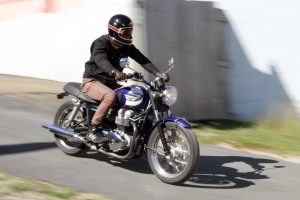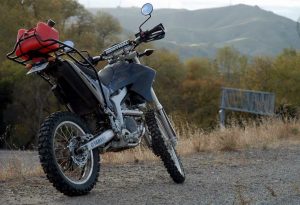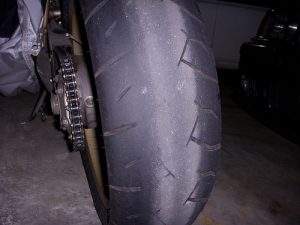Getting around may become harder in the months – and years – ahead. What good is a car without gas? Or a motorcycle without tires?
I’ve written previously about the many merits of motorcycles – leaving aside the fun of riding. A motorcycle uses less gas than a hybrid car and costs far less to buy. It will also never need a new battery (other than its starter battery) and you will still be able to start it even if it doesn’t have a charge.
Or a kick starter, for that matter.
Most motorcycles are so light that they can be easily rolled to the nearest hill and then all you have to do is get on, pull the clutch in, roll it down the hill and release the clutch once you’re rolling to get the engine running.
And you won’t even need to do that if you have a good battery. Get an Absorbed Glass Mat (AGM) battery for your bike now and you ought not to have to worry about roll-starting it for years, even if the grid goes down.
AGM batteries last longer than standard lead acid batteries – the kind you add acid to, that have liquid acid sloshing around inside them. They have the virtue of not leaking acid on your bike’s frame for that reason but the main virtue is they’ll generally hold a charge for many years and so keep your bike ready to roll without having to roll it.
Assuming you have gas.
This is another motorcycle virtue – in that bikes don’t need as much as cars do. They also go a lot farther on a gallon of gas than most cars do. A street-legal dual-sport with a 250 cc or so engine typically averages 80-100 MPG. Thus, two five gallon jugs will allow you to travel about 1,000 miles on such a bike. Used for local, shorter-distance travel, that will allow you to travel for a long time. Especially if you have four five gallon jugs. Stored properly – sealed jug, topped off and the fuel mixed with stabilizer – that could keep you emergency mobile for six months or even a year.
Assuming you have good tires.
This is one of the motorcycle’s few deficits. Bikes have only two tires and just one of the two must take all of the engine’s power; this plus usually softer bike tire compounds tends to result in much faster wear. Some “sport” tires will be worn to the cords after as little as 2,000 miles, depending on the bike and how aggressively it is ridden. The “knobbies” used on off-road and dual-sport bikes tend to fare just as poorly when a bike is ridden regularly on road.
Accordingly, even if your bike has good tires now, it’s wise to remember it is not likely to have them soon – unless you don’t ride it much. Therefore, it is probably a good idea to get a fresh set now and either install them or store them for when you will need them. So that you have them in hand in the event they are no longer available. Plus tubes, if your bike uses them.
It is also probably a good idea to get some tire-irons and learn how to mount a tire on your lonesome, in the event there’s no longer a bike shop you can go to – or that will do business with you, for refusing to wear a Face Diaper or present your Proof of Jab. It is not rocket science to change a bike tire; it’s just a physically tough and grimy job without the advantage of machines.
Might be a good idea to brush up on the technique.
But if you put fresh tires on your bike now, you will have time to study up. A new set will buy you at least a year to study while you ride and that can be extended with judicious use to two or even three years – and that ought to be enough time to get through what may be coming.
Other small stuff to consider now – before it may be too late:
Chain and sprockets; if they’re not nearly new or in nearly new condition, change them now. Or at least buy a spare set to have on hand.
Brake pads and brake/clutch fluid. Same as above. Brake pads on bikes usually last a long time but if you don’t have them and can’t get them, you won’t be able to ride. Or rather, stop riding. Remember to change out the brake/clutch fluid once a year to avoid having to change out expensive parts and possible hard-to-get parts like calipers and master cylinders.
Oil and filter. Obvious, but really important – especially if the bike is air (and oil) cooled. Bike engines are harder on oil than car engines and most bikes require bike-specific oil because the transmission/clutch share a common sump with the engine. Do not use oil meant for a car engine in a bike engine. Have enough on hand to change it once, at least – and you’ll have enough to keep you emergency mobile for a year, at least.
Don’t forget the filter, either!
. . .
Got a question about cars, Libertarian politics – or anything else? Click on the “ask Eric” link and send ’em in!
If you like what you’ve found here please consider supporting EPautos.
We depend on you to keep the wheels turning!
Our donate button is here.
If you prefer not to use PayPal, our mailing address is:
EPautos
721 Hummingbird Lane SE
Copper Hill, VA 24079
PS: Get an EPautos magnet or sticker or coaster in return for a $20 or more one-time donation or a $10 or more monthly recurring donation. (Please be sure to tell us you want a magnet or sticker or coaster – and also, provide an address, so we know where to mail the thing!)
My eBook about car buying (new and used) is also available for your favorite price – free! Click here. If that fails, email me at EPeters952@yahoo.com and I will send you a copy directly!












According to BP 2018 Statistical Review of World Energy data, wind, water and solar only accounted for 9.4% 0f total energy consumption in 2017.
Even if we make the assumption that these types of energy consumption will continue to achieve the same percentage increases as they have achieved in the last 10 years, it will still take 20 more years for wind, water, and solar to reach 20% of total energy consumption.
Thus, even in 20 years, the world would need to reduce energy consumption by 80% in order to operate the economy on wind, water and solar alone. To get down to today’s level of energy production provided by wind, water and solar, we would need to reduce energy consumption by 90%.
is this why they want to reduce the population by 90%?
https://www.zerohedge.com/energy/true-feasibility-moving-away-fossil-fuels
Change your brake fluid to DOT 5 silicone. Just remember to flush, you dont want to mix with the lower dot stuff. Advantages of DOT 5- does not attract water, does not peel paint, does not hurt your hands, can handle much higher caliper temps during racing, lasts years, especially in bikes that sit a lot like show queens. Disadvantages- cannot be used with ABS, expensive…..the same is true in cars.
In a SHTF scenario, brake fluid can be home made of 50/50 corn or vegetable oil and alcohol. This would be DOT2, but youre gonna want to flush it when you can
Great article, Eric.
As a former MX, TT and roadracer, ran across this
https://tinyurl.com/39t4p5z9
which I know will be of interest.
BTW, 50 years ago took a class in tire changing as prep for competing in the ISDT (on a Penton). Still wouldn’t attempt to change a knobbie without a tire changing stand and two huge tire irons.
Thanks, Clay!
I’ll be doing my ZRX today, hopefully… assuming I’m not Hut! Hut! Hutted! for my latest rant, at any rate!
Seriously?
If we’re going to just roll over and capitulate to Chicken Little Inc. then let’s stop fucking around and fast forward to the end game.
Bicycles…skateboards…wooohoo!
Eric,
If you get a dual-sport or enduro style bike, you can get tires that’ll be good both on and off road. Mind you, that these tires aren’t pure knobbies, so you won’t be able to mix it up with the MXers in soft dirt, sand, or mud; a dual sport isn’t optimized for that anyway, as it’s heavier than a pure MXer. That said, you’ll be able to go places where cars and most trucks can’t go; I’m assuming that’s why you’re recommending we have a dual sport bike: to go where most people, especially Johnny Law, can’t go.
As for the mount (i.e. motorcycle), the LAST thing I’d want is a big, heavy adventure bike! BMW was making a 1250 cc version of it’s G/S! Are you KIDDING me?! Who’d want to haul that pig off road? Who’d want to feed it gas, which may be scarce? The biggest bike I’d opt for is a 650. I’d rule out the Kawasaki KLR, because it has water cooling; that’s just more shit to go wrong when you can least afford that. The KLR is also less optimized for off-road use in its second generation (post 2008 or so). That leaves us the Suzuki DR650 and the Honda XR650. Both are air cooled; both are proven; and both can be had for $7K-NEW!
So, which of the two do you choose? The Honda is basically a big, street legal dirt bike. It’s survived the Baja 1000! It’ll take off-road abuse. That said, they used to have an issue with the ignition module or something; Motorcycle Consumer News did a comparo between the Jap dual sports, and they mentioned that. I’d reasearch any forum devoted to the big Honda, find out what it is, then make sure I have an extra one or two of these critical modules.
That leaves us the Suzuki DR650. While the Kawasaki is too road friendly for the intended purpose here; while the Honda is a big, street legal dirt bike; the Suzuki strikes a nice balance between the two. It’s been around decades; other than the color, little on the bike has changed. It has air and oil cooling. It has a nice aftermarket; whatever you want for the bike, you can get it. For example, you can swap out the small, stock fuel tank, and put in a nice, big 5 gallon tank. It’s not too civilized, as is the KLR; it’s not a street legal dirt bike with lights; the Suzuki is like Goldilocks-JUST RIGHT!
Something to keep in mind with dual sport tires is that they’re not all created equal. Some are biased for mostly on-road use; some are biased for mostly off-road use; while others offer a good mix of both on and off-road. I just looked at a couple of motorcycle tire company websites, and they no longer feature a ratio in the specs like they used to. A few years ago, they’d say that a particular dual sport tire was 90/10, 80/20, 60/40, and so on; that ratio referred to on vs. off road use. If it were a 90/10 or 80/20 tire, then it was biased for mostly on-road use, and its treat pattern would reflect that. If it were a 50/50 or 30/70, it would be more biased for riding off-road. The ratio, I thought, was a very useful piece of info, because it’s easy to visualize how it relates to your typical riding or intended riding. WTF did the tire makers omit this useful piece of info?!
I took a quick look at three motorcycle tire makers websites: Avon, Pirelli, and Michelin. If you’re looking for a mostly on-road tire (like 90/10 or 80/20), then Avon’s Trailrider, Pirelli’s Scorpion Trail, or Michelin’s Anakee 3 would be good choices. If you’re looking for something that can do both on and off-road, then Avon’s Trekrider, Pirelli’s MT 60, or Michelin’s Anakee Adventure would be good choices; they look like 70/30 or 60/40 tires. I’d personally opt for a 70/30 or 60/40 tire, since it’ll enable me to use paved roads until I wish to leave them; once I go off road, I’ll be able to continue moving. A 90/10 or 80/20 tire would enable me to use fire roads, but that’s about it. A 60/40 tire would enable me to leave the fire road if necessary.
Without having prior experience with any of these tires, at first blush, I’d go with either the Avon Trekrider or Pirelli MT 60. The Trekrider looks like it would hook up fairly well off road (as long as you’re not in soft dirt, mud, or sand), while having enough meat to carry you on asphalt for long distances while transiting to the trail head. The Pirelli MT 60 has been around a long time, and I reckon there’s a reason for that; it’s stood the test of time, while other dual sport tires have come and gone. That tells me it’s popular with dual sport and adventure riders, and I’d bet that any adventure riding forum would reflect this. Here’s a review of the MT 60 on Web Bike World: https://www.webbikeworld.com/pirelli-mt60-tire-review/
Oh, before I forget, if you’re recommending people get a dual-sport bike for bug out purposes, they typically come with spoked wheels. Look at Kawasaki’s KLR, the Suzuki DR650, etc.; they have spoked wheels. SO! In addition to the tires, folks will need to get extra tubes and rim strips for them too; when the a tube type tire is changed out, the tube and rim strip need to be changed too. DON’T FORGET EXTRA INNER TUBES AND RIM STRIPS, GUYS! I’d recommend both heavy duty tubes and rim strips.
Finally, I don’t know if it’s a good idea to hang on to tires for years. Even if a tire is new when you get it, if it sits 4-5 years in your house before needing it, it won’t have as much grip as it used to. Rubber gets harder and loses grip with age. I would say that, until things go bad, when it’s time to change tires and tubes and rim strips, use your extras; use what you have on hand, then replace it with brand new immediately when you install them. This is so you’ll always have fresh tires, tubes, and rim strips when you need them most. If you don’t need them, then the worst that’s happened is that, when you need to change your tires, you already have ’em on hand.
In closing, my go-to bikes would either be the Honda XR650L or the Suzuki DR650; personally, I’d opt for the Suzuki, as it offers a balance of on and off road riding. if you get a dual sport or adventure bike, it’ll most likely have spoked wheels; wire wheels mean inner tubes and rim strips. When the tires are changed, the tubes and rim strips need to be changed too. Not all dual sport tires are equal! For the intended purpose, I’d lean to a 70/30 or a 60/40 type of tire. High on my list for dual sport tires would be the Pirelli MT 60; it’s stood the test of time, which is a vital consideration here. While keeping a good carcass and tread design, Pirelli’s updated it newer compounds over the years. It’s road friendly enough to get you out of your city or town, then hit the trail once you reach it.
Changing tires on a motorcycle probably sucks. Do they make split rims? I always thought that was a cool idea for a car/truck, though I know there are downsides.
Hi BaDnOn,
It’s not so much changing the tire as pulling the wheel, which requires jacking up the bike (if it hasn’t got a center stand) and that is a PITAS if you haven’t got a bike jack/support. Also, the axle has to come out, some spacers, the brake caliper, etc. It’s not a difficult job, technically. Just more hassle than pilling a wheel off a car!
Gotcha, Eric.
So I’m guessing putting the tire on the rim isn’t too much more difficult than a bicycle tire? Try not to laugh if it’s a silly question. I’ve never owned a motorcycle (other than a kit bike conversion).
I would love it if I could save money on car tires by just buying the tires and mounting them on the rims myself, but that requires expensive equipment, save for the advent of the aforementioned split rims.
Hello Ba. There are videos on YT showing how to change car tires at home. Also the balancing is just as costly as a change/balance job.
Youse guys haven’t lived until you’ve changed a 13×5-6 tire on a castor wheel on a commercial zero-turn mower! (With screwdrivers and other improvised tools). Little tires can be harder than big’uns!
Years ago, I wanted to replace the toy spare in my Chevette with a full-service spare. First, I needed a wheel, so I went to one of the local pick-a-part yards and pulled one off another Chevette. It had a thrashed tire on it, but the wheel was still good.
If I’d been smart about it, I would’ve had a tire shop remove the tire so I could paint the wheel before getting a new tire put on. Instead, I figured it couldn’t be that much more difficult than changing a bicycle tire…right? I’d done that plenty of times.
It ended up taking probably an hour or two with the tire iron from the car and an assortment of screwdrivers…including a 3-foot-long flat-bladed monster. The bead on the tire was chewed up, but since it was junk already, big deal. I washed and painted the wheel, let it dry, and had a tire shop mount a tire on it.
I had the opportunity to do the same maybe 10 years later when the toy spare on my S-10 disappeared. This time, I just picked up a wheel at the pick-a-part and let a tire shop do the rest of the work!
P.S. My statement isn’t ENTIRELY true. Once I bought a dirt bike for $150, but the muffler was shot, and it was louder than hell. My dad told me to “get that piece of shit out of my yard”. SO, technically I owned a dirt bike once for about 20 minutes.
I change dual sport tires myself. I use heavy ratchet straps to lift the bike from the framing in the garage. You could also use a swing set or make a simple gantry out of studs. You only have to lift 400lbs max for the fattest dual sports, less if you lift only one wheel. The wheels come off with a few fasteners. Let the air out and dig the tire off with motorcycle tire levers or “spoons”. Getting them back on with the tubes can be a sonofabitch. Watch some videos of how to change a dirtbike tire.
I look at it another way: As the system disintegrates, and the medical cartel becomes more and more weaponized, it would behoove us to be even more diligent to avoid serious injury that would require reliance upon EMS/hospitals/doctors/drugs= which have all essentially become extensions of rabid government (Not to mention the financial cost, and resulting temporary or very possibly permanent disability).
It’s hard enough to remain mostly free now -imagine having to do so while being reliant upon doctors, and having to pay for them and hospitals and maybe a helicopter ride (if such a service even remains in the near future)….having to lay in bed for 6 months…and maybe never being able to do the things you used to, just because you went down, or got nailed by a distracted driver. Even if you were willing to accept the risks of riding in the past- it might be wise to reconsider now, since the consequences of major inury and disability (even temporary disability) are becoming more and more severe, and would likely render one unable to remain free- possibly forever.
I’d imagine that the Hollywood movies portraying post-apocalyptic zombie apocalypse scenarios likely portray the independent as freely tooling around on motorcicles, but in reality in such a situation, anyone who intends to survive and remain free will take extra precautions to safeguard their bodily safety and eliminate or greatly reduce exposure to sources of possible serious injury- which means having plenty of real, solid metal around you when you are hurtling down the road at 88 feet per second or more……
If gas becomes scarce and the economy falls apart the roads will be much like the fifteen days to slow the spread – nobody on the roads. Riding a motorcycle is pretty safe when you can go at your own pace and not worry about two ton meat grinders. A japanese 50cc scooter would be even safer and more fuel sippy but not good for the off-road bugout.
Don’t store tires near your air compressor or other electric motors. The ozone will destroy them.
A motorcycle is an awesome second vehicle. Mine has saved me many times when the four wheeled cage has needed repairs. Just recently the transmission oil cooler line on my truck sprung a leak, another gift from the salt gods of new england. The bike allowed me to get to the auto parts place for supplies. It’s saved the repair day when I’ve had a vehicle torn apart for repair and needed unforseen extra bits halfway through as well.
Some extra things to keep around to keep your bike going…
-A solar or mains powered trickle charger for the battery will keep a battery cranking like new for many years.
-Keep extra chain and cable lube around and use it often. Neglected control cables and stiff, prematurely worn drive chains will get you stranded or dead.
-A tire patch kit and tire levers. Plugs work fine on nail punctures in car tires but I wouldn’t trust them on a bike. They’re also useless on tubes.
Great advice Eric, especially tires.
Another biggy is look for the date code on tires. Older then 10yrs is risky, even with good tread. See it all the time.
Thanks, Chris!
I’m actually in the midst of doing this prep work for my ’03 ZRX 1200 – so it’s a two-fer. An article and a project!